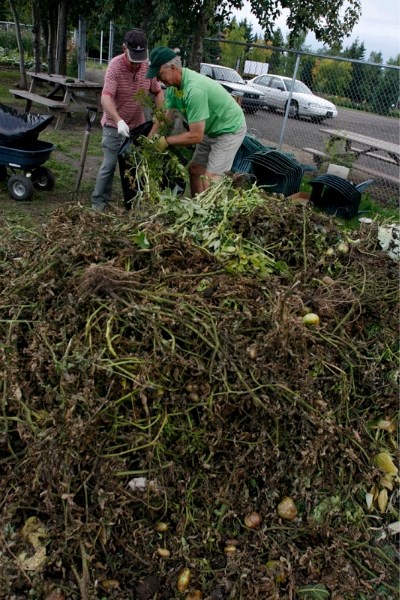The province will use a three-pronged approach to educate members of the public, including commercial growers, about late blight, a disease that destroyed tomato and potato plants across the province, including St. Albert, last year.
With last summer’s heavy rain and high temperatures, conditions were ripe for the disease, according to Ron Howard, a plant pathology research scientist with Alberta Agriculture.
“What was different about 2010 compared to what we’ve seen in the past was that our past outbreaks of late blight have pretty much been confined to potatoes and primarily commercial potatoes in fields in southern Alberta and to some extent to central Alberta as well,” Howard told the Gazette.
“In 2010 we saw a very unusual situation. We actually saw the disease showing up first off in tomatoes.”
Howard said the disease first started showing up in home gardens and market gardens.
“That’s how we believe it came here, it was introduced on infected transplants grown out of province and when those were planted out in gardens and the rainy weather followed, the disease gradually got a toe-hold and began to spread,” he said.
Howard said the last major outbreak of late blight was in the early 1990s.
He said the province’s awareness campaign last year included press releases, grower meetings and articles primarily directed to the commercial potato industry where there was the biggest concern.
But with concerns the disease could resurface, Howard said the province will step up its awareness campaign in 2011.
With the help of the Alberta Professional Horticultural Growers and Congress Foundation Society and the Potato Growers of Alberta, Howard has drafted a proposal that includes surveys and public awareness campaigns about late blight.
The first step, he said, is to make people aware of the disease and the problems it caused for growers in 2010.
“To do that we want to try and reach out to garden centres, the garden clubs, to professional potato growers, organization groups like that and put into their hands information products such as a fact sheet and opportunities to do some training and awareness,” he said.
The second step will involve sending surveyors to garden centres and bedding plant greenhouses that grow tomatoes to look for signs of the disease which, on tomatoes, include discoloured lesions and a fuzzy white growth on the leaves. This substance produces spores that become wind-born and spread to other plants in the vicinity.
“Eventually the whole top will die down completely and the fruit will be rotted. They’ll develop brown to blackish lesions on the fruit,” said Howard.
He is hoping that with the co-operation of garden centres and greenhouses, more people will be watching for signs of blight this year.
Should the blight reappear, Howard said the province wants people to be aware of how to properly dispose of infected plants.
“I think commercial potato growers are well aware of this but for home gardeners, we want to make sure they understand what the options are for late blight,” he said.
Derrick Harrison, president of the St. Albert & District Garden Club said late blight was first noticed at St. Albert Botanic Park last summer. He said information was then sent to all club members, as well as to the City of St. Albert, regarding how to identify the disease and how to properly dispose of infected plants.
“The major concern was to stop the spread of it any further and to warn people about it. One of the main things was not to just ignore it but to actually dispose of it,” Harrison said.
Infected plants were removed from the park and properly disposed of in black garbage bags provided by the City of St. Albert, said Harrison. However, he said there is still some concern the disease could have survived here over the winter.
“The major concern regarding surviving the winter is for any potatoes that people have saved that have been infected with the blight. As far as tomatoes are concerned, no, the winter will kill them,” Harrison said.
“If people have saved any of the potatoes and replant them, that is where you can get a reoccurrence.”




